17th October to 8th November 2008
Introduction:
My Edinburgh friends, Graeme and Moira Wallace invited me to join them on a trip to Bahia guided by Ciro Albano. I had met Ciro on a trip to Caxiuanã organised after the Ornithological Congress of 2005 and before he had started guiding bird tours. I also knew that Graeme and Moira had been very pleased with Ciro when he guided them in Ceará in 2007. See Graeme's Trip Report.
So I happily accepted the invitation. I was also interested in seeing a bit of Ceará and luckily Ciro was available for a week or so before the Bahia trip. I then planned to spend a few days in the south-east with my friends Jeremy Minns and Ricardo Parrini which I did but have not included this last week in my report.
Preparation:
Since I know Brazil quite well I didn't do much in the way of preparation. There still isn't a decent field guide though Ciro did show me the new Tomas Sigrist Field Guide for Eastern Brazil which is a big improvement on what has been available. I still have my home made Field Guide which I still find useful though I hardly used it when Ciro was at hand. I knew Ciro would have playback tapes but I did try to remind myself of the most common vocalisations using xeno-canto. The one site that I knew Ciro hadn't been to was the Streseman's Bristlefront site at Mata de Balbina in northern Minas Gerais and I found a short report from Andrew Whitehouse on Birdforum.
Getting there:
I managed to find a trip from London to Fortaleza via Lisbon on TAP so I travelled out that way, took a TAM flight from Salvador to São Paulo and travelled BA back to London.
Transport:
Ciro had hired a Fiat Doblo which had plenty of space for the four of us and proved to be more than adequate for our purposes. The one place that it struggled was the Serra Bonita Reserve at Camacã but they offer 4WD transport up the hill if you contact them beforehand.
Money:
Almost all petrol stations accept credit cards but it is wise to ask before you fill up as they sometimes aren't working. About half the hotels and lodges we stayed at accepted credit cards (chiefly Visa and Master Card) and the other half accepted only cash. It is now possible to use a cash card at many of the Bradesco ATMs. I had taken enough cash with me but the Wallaces used them on a couple of occasions with (eventual) success.
Accommodation:
Ciro had done all the booking and all the accommodation was more than adequate to excellent. I found the lodges at Serra Bonita Reserve, Camacã and Fazenda Michelin to be quite exceptional and my favourite hotel was the Pousada de Araras in Puerto Seguro. We don't often get to stay at tourist resorts when birding but Porto Seguro is one and the restaurants were great.
Guide:
I was very impressed with Ciro as a guide. He has become very professional in quite a short period of time. His ability with voices must be amongst the best in Brazil and he has a deep knowledge of the birds and the birding scene in Brazil. He has an amazing jacket of many pockets out of which he produces laser pointers, tape recorders, microphones, i-pods and speakers not to mention various photographic bits and bobs when he is photographing. I would thoroughly recommend him to any birder but particularly if you are interested, as I am, in bird photography. His e-mail is ciroalbano@yahoo.com.br and he has some of his photos on http://ciroalbano.multiply.com/
Itinerary:
Friday, 17th October: Fortaleza to Itapajé
I arrived at Fortaleza airport almost 2 hours late at 9:00 pm to be met by Ciro Albano who was to look after me very well for the next few weeks. We set off on a two hour drive west of Fortaleza to Itapajé where we arrived just after 11:00 pm for a beer and a snack before crashing into bed at the Hotel Luz do Sol.
Saturday, 18th October: Itapajé to Serra de Baturité
Up at 3:00 am and off to Hermann Redies Mãe da Lua Private Reserve in a nice area of caatinga. Hermann has some excellent photos of caatinga species plus details of how to visit the reserve on his website at http://www.birds-caatinga.com/index.html. After a quick cup of coffee he took us in his Land Rover to a hide he has prepared overlooking a spring. It is a one or two-man hide so I was ensconced in it by 4:00 am while Hermann and Ciro went off elsewhere.
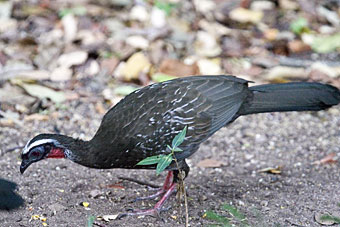 The
main target was White-browed Guan and at about 5:00 a.m. I heard then saw them as they headed towards the spring. I counted 10 including one youngster but there were more to another side of the hide and I would guess that there were about 14 in total. At that time in the morning the light was very poor and I didn't want to spook these very nervous birds with flash but I got a few photos at ISO 6400 of this Vulnerable and difficult to see species. After a marvelous 15 minutes or so something did spook them. I suspect that a group of White-naped Jays may have detected my presence and raised the alarm. The guans left as quickly as they arrived leaving me with excellent views of the jays, White-tipped Dove, Pectoral Sparrow, Pileated Finch, Golden-crowned and Flavescent Warbler and a very obliging female Great Antshrike.
The
main target was White-browed Guan and at about 5:00 a.m. I heard then saw them as they headed towards the spring. I counted 10 including one youngster but there were more to another side of the hide and I would guess that there were about 14 in total. At that time in the morning the light was very poor and I didn't want to spook these very nervous birds with flash but I got a few photos at ISO 6400 of this Vulnerable and difficult to see species. After a marvelous 15 minutes or so something did spook them. I suspect that a group of White-naped Jays may have detected my presence and raised the alarm. The guans left as quickly as they arrived leaving me with excellent views of the jays, White-tipped Dove, Pectoral Sparrow, Pileated Finch, Golden-crowned and Flavescent Warbler and a very obliging female Great Antshrike.
 Hermann and Ciro collected me at 8:00 am and we went back for coffee and some cheese. Hermann charges R$50 for entrance to his reserve, R$20 for the use of the Land Rover and I left a little bit extra. The work he is doing in preserving this area of caatinga is exceptional and far from easy. Just after I got back to Britain I learned that someone had tried to start a fire on his property but fortunately did not succeed in causing much damage.
Hermann and Ciro collected me at 8:00 am and we went back for coffee and some cheese. Hermann charges R$50 for entrance to his reserve, R$20 for the use of the Land Rover and I left a little bit extra. The work he is doing in preserving this area of caatinga is exceptional and far from easy. Just after I got back to Britain I learned that someone had tried to start a fire on his property but fortunately did not succeed in causing much damage.
By 10:00 am we were on the road again heading back through Fortaleza and on to the Serra de Baturité. The town of Baturité lies at the foot of the Serra and there we had a quick lunch before climbing to our hotel, the aptly named Alto da Serra which lies at about 800 masl.
There was some good birding around the hotel then we set off for the village of Pacoti where we sat down on the benches of the shrine to Santa Rita and waited for the Critically Endangered Grey-breasted Parakeet to come into their roost at a nearby nest site. This they duly did just as the sun was going down. A lovely parrot.
After an early dinner I collapsed into bed at 8:00 pm after a very long and very successful day. Could Ciro keep up this pace?
Sunday, 19th October: Serra de Baturité
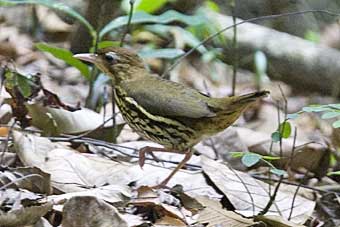 At 5:00 a.m we were off to the neighbouring Hotel Remanso which has some excellent trails through the forest though, at the weekends, it can be a noisy place to stay.
At 5:00 a.m we were off to the neighbouring Hotel Remanso which has some excellent trails through the forest though, at the weekends, it can be a noisy place to stay.
By 10:00 a.m. we had seen and photographed many of the
important birds including the cearae sub-species of Rufous Gnateater, a
Short-tailed Antthrush crossing the trail, Rufous-breasted Leaftosser and the
local sub-species of Buff-throated Woodcreeper. We headed back to our own
hotel where we photographed a few more birds before meeting up with
Ciro's colleague, Weber - the discoverer of the Araripe Manakin, 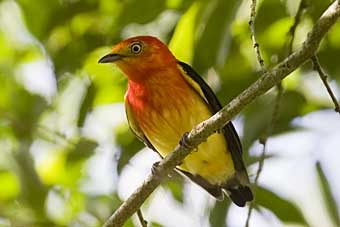 and his team who were installing artificial nest boxes in the hope that they will be used by Grey-breasted Parakeet.
and his team who were installing artificial nest boxes in the hope that they will be used by Grey-breasted Parakeet.
We had lunch in the town of Guaramiranga which in the local Indian language means "little red bird" and refers to the Band-tailed Manakin that we had seen the previous day.
The afternoon at the Hotel Remanso was quiet though we did see the local sub-species of Gould's Toucanet and we ended the day back at the lovely Grey-breasted Parakeet.
Monday, 20th October: Serra de Barurité and Morada Nova to Chapada de Araripe
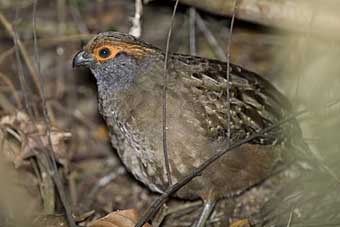 By 4:30 a.m. we were up and off again to the Hotel Remanso. Our main target this morning was Spot-winged Wood-quail but it initially sang from quite a distance. We followed the trail in the general direction of the songs and eventually Ciro brought them in very close and I managed to get some brilliant photos. This is a species that I have often wondered if I would ever see far less photograph.
By 4:30 a.m. we were up and off again to the Hotel Remanso. Our main target this morning was Spot-winged Wood-quail but it initially sang from quite a distance. We followed the trail in the general direction of the songs and eventually Ciro brought them in very close and I managed to get some brilliant photos. This is a species that I have often wondered if I would ever see far less photograph.
We also managed to photograph the local atlantidus sub-species of Lesser Woodcreeper. This is probably going to be elevated to the status of a full species in the near future. Then back to our hotel for breakfast at 7:30 and on our way to Morada Nova.
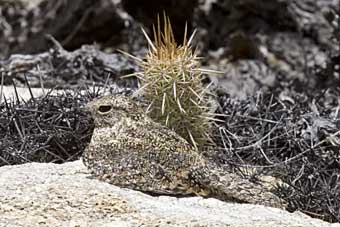 The attraction of Morada Nova is the daytime roost of Pygmy Nightjar. One wonders how such places are discovered until one discovers that the farm, Fazenda Serratinho, which hosts the roost, belongs to Sr. Sinaldo, the uncle of Weber of Araripe Manakin fame. We picked up Sr. Sinaldo who shows us the roost on a rocky outcrop in the middle of farmland. It is remarkably similar to the type of site used as a roost by Blackish Nightjar. We saw and photographed quite a few birds and came across two nests each with a single egg. The term "nest" in this case refers to a small hollow in the rock without any apparent addition by the bird. It is very hot and the sun is directly overhead as it is almost midday. The birds have to sit on the eggs in order to keep them cool - a novel concept for me.
The attraction of Morada Nova is the daytime roost of Pygmy Nightjar. One wonders how such places are discovered until one discovers that the farm, Fazenda Serratinho, which hosts the roost, belongs to Sr. Sinaldo, the uncle of Weber of Araripe Manakin fame. We picked up Sr. Sinaldo who shows us the roost on a rocky outcrop in the middle of farmland. It is remarkably similar to the type of site used as a roost by Blackish Nightjar. We saw and photographed quite a few birds and came across two nests each with a single egg. The term "nest" in this case refers to a small hollow in the rock without any apparent addition by the bird. It is very hot and the sun is directly overhead as it is almost midday. The birds have to sit on the eggs in order to keep them cool - a novel concept for me.
After a snack at a petrol station we set of for the Chapada de Araripe and arrive at the Encosta da Serra Hotel in Crato at about 5:00 p.m. after a very long day's drive. We have a quick search for the Manakin and catch fleeting glimpses in the dying light.
Tuesday, 21st October: Chapada de Araripe
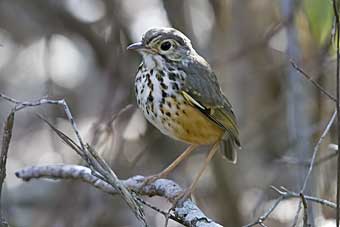 Up at 4:45 a.m. and off to the top of the Chapada which is reached by climbing the steep escarpment. Gradually the habitat changes from full-blown Atlantic Rain Forest through "cerradão" to what is called "carrasco" which is basically "caatinga without thorns".
Up at 4:45 a.m. and off to the top of the Chapada which is reached by climbing the steep escarpment. Gradually the habitat changes from full-blown Atlantic Rain Forest through "cerradão" to what is called "carrasco" which is basically "caatinga without thorns".
We had a very successful morning with excellent photos of, amongst others, Great Xenops, Caatinga Antshrike and Caatinga Antwren as well as some interesting photos of a pair of piculets. These showed some signs of hybridisation between Spotted and Tawny Piculets and Ciro might well be writing a short note on these. The highlight of the morning however was a pair of White-browed Antpitta who surprised us by emerging into the open at the edge of the carrasco affording us superb views and photo opportunities.
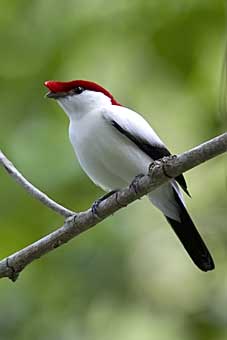 We returned to the hotel for breakfast and then set off for the Arajara Water Park - an unlikely site at which to see the Araripe Manakin. This bird was only described in 1998 although, as you can see from the photo, it is quite distinctive. Ornithologists and birders had been going to the Chapada de Araripe for years but always to the forest and other habitats at the top of the Chapada never to the foot of the escarpment. Here a whole series of foot-of-escarpment springs created the habitat for the Araripe Manakin. Interested locals had reported the existence of the bird but it had been assumed that it was a Red-cowled Cardinal from the descriptions given.
We returned to the hotel for breakfast and then set off for the Arajara Water Park - an unlikely site at which to see the Araripe Manakin. This bird was only described in 1998 although, as you can see from the photo, it is quite distinctive. Ornithologists and birders had been going to the Chapada de Araripe for years but always to the forest and other habitats at the top of the Chapada never to the foot of the escarpment. Here a whole series of foot-of-escarpment springs created the habitat for the Araripe Manakin. Interested locals had reported the existence of the bird but it had been assumed that it was a Red-cowled Cardinal from the descriptions given.
The Araripe Manakin is classified as Critically Endangered and there are probably only 800 individuals left in this very restricted range. The habitat is under extreme pressure from holiday homes and other developments in this attractive, moist area in the middle of a fairly arid area of north-east Brazil but efforts are being made to conserve the habitat and protect the bird. Sir David Attenborough has just become the species champion which is a huge feather in the cap of Ciro and his colleagues in Brazil who are looking after the species.
Wednesday, 22nd October: Chapada de Araripe to Tamandaré
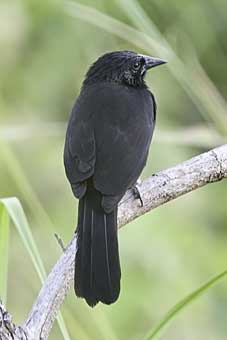 We had a long journey in front of us so we decided not to go out in the early morning but have an early breakfast and get on our way.
We had a long journey in front of us so we decided not to go out in the early morning but have an early breakfast and get on our way.
After an 8 hour journey and just before arriving at Tamandaré Ciro slowed down a bit and eventually stopped. We got out at the side of the main road and heard Forbes' Blackbird calling. We then proceeded to get excellent views and photos of this Endangered bird with probably less than 2,000 individuals remaining. I even managed to get a photo of its display when it spreads out its wings and throws its head back so that it is resting on its back. There were only two birds rather than the small flocks normally seen and we judged that this fact plus the display plus the close views meant that the pair were about to breed.
In the middle of the seaside town of Tamandaré we stopped for a couple of beers in a restaurant which is a stake-out for Plain-bellied Hummingbird. This duly appeared to get its photo taken. I do enjoy watching birds with a beer in my hand.
Thursday, 23rd October: Tamandaré
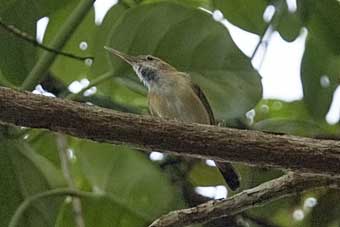
We left the pousada at 5:00 a.m. and went off to the Saltinho Reserve. Ciro had received prior permission to enter but passports and id cards were still required. It is nice lowland forest with a good main trail and we saw several good birds including White-shouldered Antshrike, Pale-bellied Tyrant-manakin, White-bellied Tody-tyrant and Streaked Xenops. We had distant views of Yellow-faced Siskin, a species now classed as Vulnerable due to the decimation of its numbers as it has been caught for the caged bird trade almost to the edge of extinction.
My main target was Long-tailed Woodnymph which I had seen only briefly before and I saw only briefly again. It is a hummingbird that doesn't seem to hang about in the same place for very long. Rufous-breasted Hermit on the other hand showed extremely well at the same flowering shrub.
In the afternoon we visited another forest remnant which proved quite productive and produced some reasonable photos of Long-billed Gnatwren.
Friday, 24th October: Tamandaré to Sauipe
Our aim this morning was to see Forbes' Kite. To my dismay, when we got up at 4:45 a.m. it was pouring with rain. We did drive towards the forest remnant but we were heading into even darker clouds and the dirt road we needed to drive along would have been impassible. So we will leave him for the next trip!
After breakfast at a padaria we headed south through Maceio, Alagoas and past Aracaju, Sergipe. Just at the border with Bahia we were stopped by the police who discovered that our fire extinguisher was out-of-date so we had to return to the nearby petrol station to buy a new one. They seemed to have a very healthy stock of fire extinguishers at that petrol station!!!
Having lost a bit of time we didn't go birding in the evening and I settled into the hotel in Sauipe while Ciro went to pick up Moira and Graeme Wallace for the main part of the trip.
Saturday, 25th October: Sauipe to Lençois
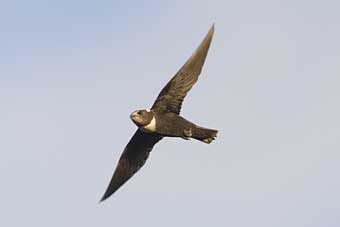 Up at 5:00 a.m. and off to the Parque Sauipe owned by the company Cetrel. Our principal target was Fringe-backed Fire-eye but unfortunately there was neither sight nor sound of the bird. We did see a Tropical Screech-owl that had made its nest in one of Pedro Lima's nest boxes but otherwise it was fairly quiet probably due to the prolonged dry season in the area. Ciro took us to another site further north but again there was no sign of the Fire-eye.
Up at 5:00 a.m. and off to the Parque Sauipe owned by the company Cetrel. Our principal target was Fringe-backed Fire-eye but unfortunately there was neither sight nor sound of the bird. We did see a Tropical Screech-owl that had made its nest in one of Pedro Lima's nest boxes but otherwise it was fairly quiet probably due to the prolonged dry season in the area. Ciro took us to another site further north but again there was no sign of the Fire-eye.
So we went back to the hotel, had breakfast and set off for the Chapada Diamantina. We arrived at Lençois at about 5:30 p.m. to be greeted by a tremendous show of Biscutate Swifts. Some were flying low over the approach road but in town there was a distant flock circling which we reckoned to number about 4,000 birds.
We had our usual warm welcome to the Casa da Geléia from Lia and Zé Carlos then went off for an excellent dinner at the Picanha na Praça Restaurant.
Sunday, 26th October: Lençois to Mucugê
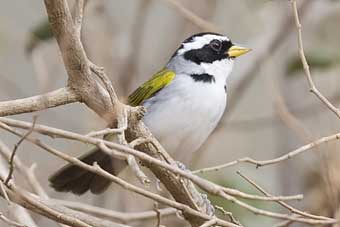 Up
at 4:00 a.m. for Lia's excellent breakfast and off to the road from Palmeiras to Guiné where there is a nice area of caatinga. We saw a good selection of caatinga birds including Silvery-cheeked and Caatinga Antshrike, Planalto Slaty-Antshrike, Caatinga Antwren, Red-billed Scythebill, Sooty-fronted Spinetail and Long-billed Wren. However, the star of the morning was San Francisco Sparrow. This bird is normally a real skulker and I had a very poor photograph of a half-hidden bird taken along the same road in 2004. This time we saw the bird skulking at the side of the road and watched it for a few minutes until, to our great surprise, it flew across the road and showed extremely well at about 2 metres above the ground in a bush. We feasted our eyes (and cameras) on this remarkable sight for about 15 minutes and noticed that the bird we were watching was one of a pair, the partner acting true to form by skulking in the undergrowth below the singing bird.
Up
at 4:00 a.m. for Lia's excellent breakfast and off to the road from Palmeiras to Guiné where there is a nice area of caatinga. We saw a good selection of caatinga birds including Silvery-cheeked and Caatinga Antshrike, Planalto Slaty-Antshrike, Caatinga Antwren, Red-billed Scythebill, Sooty-fronted Spinetail and Long-billed Wren. However, the star of the morning was San Francisco Sparrow. This bird is normally a real skulker and I had a very poor photograph of a half-hidden bird taken along the same road in 2004. This time we saw the bird skulking at the side of the road and watched it for a few minutes until, to our great surprise, it flew across the road and showed extremely well at about 2 metres above the ground in a bush. We feasted our eyes (and cameras) on this remarkable sight for about 15 minutes and noticed that the bird we were watching was one of a pair, the partner acting true to form by skulking in the undergrowth below the singing bird.
As if that wasn't enough excitement for one day, Ciro
took us off to the Morro do Pai Inácio where we soon found 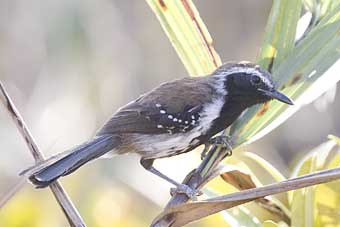 some Hooded Visorbearers. These are remarkably confiding hummingbirds and don't seem the least concerned with people approaching very close. They soon fly off however to defend their territory when a rival male appears. A pair of Pale-throated Serra-finch were also on the Morro and Ciro managed to get a recording of the curious fluttering sound made by the tail when they fly.
some Hooded Visorbearers. These are remarkably confiding hummingbirds and don't seem the least concerned with people approaching very close. They soon fly off however to defend their territory when a rival male appears. A pair of Pale-throated Serra-finch were also on the Morro and Ciro managed to get a recording of the curious fluttering sound made by the tail when they fly.
After a snack we left Lençois and headed towards Mucugê. Just before reaching our destination we stopped on the "gerais" to look for the recently described Sincorá Antwren. On my last visit to the Chapada Diamantina I had managed to get a photograph of an immature male so I was delighted that Ciro found us a fully mature male this time.
Monday 27th October: Mucugê to Boa Nova
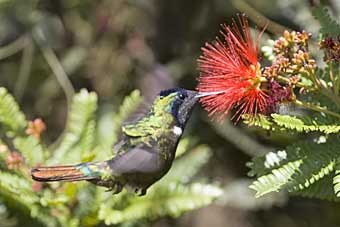 We checked out of the hotel at 5:00 a.m. and set off for the "gerais" of Mucugê where we saw many of the cerrado specialities including the two pygmy-tyrants Rufous-sided and Tawny-crowned almost side by side. We also saw White-banded Tanager, Collared Crescentchest, Rufous-winged Antshrike and Rusty-backed Antwren which was interesting to compare to yesterday's views of Sincorá Antwren. The habitat is also different with the Sincorá Antwren being found in "campos rupestres" or rocky grassland. A fleeting glimpse was also had of a magnificent male Horned Sungem but it didn't hang around long enough to have its photo taken.
We checked out of the hotel at 5:00 a.m. and set off for the "gerais" of Mucugê where we saw many of the cerrado specialities including the two pygmy-tyrants Rufous-sided and Tawny-crowned almost side by side. We also saw White-banded Tanager, Collared Crescentchest, Rufous-winged Antshrike and Rusty-backed Antwren which was interesting to compare to yesterday's views of Sincorá Antwren. The habitat is also different with the Sincorá Antwren being found in "campos rupestres" or rocky grassland. A fleeting glimpse was also had of a magnificent male Horned Sungem but it didn't hang around long enough to have its photo taken.
Then off to the bridge over the river Paraguaçu to look for the Diamantina Tapaculo a bird that was described as recently as 2007. We clambered beneath the bridge and got some pretty decent views of the bird though it proved to be very tough to photograph. As we walked along the road on the far side of the bridge Moira spotted a hummingbird feeding on some red flowers and, much to our surprise, this proved to be a Hooded Visorbearer. I spent a long time at the flowering bush trying to get photos of the bird feeding and managed to get a few good images.
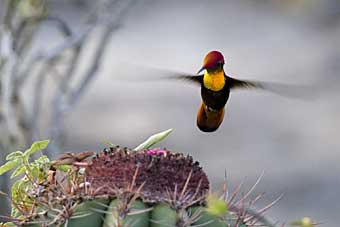 We arrived at Boa Nova at about 4:00 p.m. and checked into the Hotel Solar where we were met by Edson from SAVEBrasil (Birdlife International). We went off to a "lajeiro" where the large, flat rocks had beautiful small cacti whose flowers provided food for a large number of hummingbirds. Around the edge were some ground bromeliads, the habitat of Slender Antbird and a female appeared for a few minutes. There were also Pygmy Nightjar in the area. We then settled down to a show by the hummingbirds just as dusk closed in. We saw Swallow-tailed Hummingbird, Glittering-bellied Emerald, Sapphire-spangled Emerald and the gorgeous Ruby-topaz Hummingbird before heading back to town and our evening meal.
We arrived at Boa Nova at about 4:00 p.m. and checked into the Hotel Solar where we were met by Edson from SAVEBrasil (Birdlife International). We went off to a "lajeiro" where the large, flat rocks had beautiful small cacti whose flowers provided food for a large number of hummingbirds. Around the edge were some ground bromeliads, the habitat of Slender Antbird and a female appeared for a few minutes. There were also Pygmy Nightjar in the area. We then settled down to a show by the hummingbirds just as dusk closed in. We saw Swallow-tailed Hummingbird, Glittering-bellied Emerald, Sapphire-spangled Emerald and the gorgeous Ruby-topaz Hummingbird before heading back to town and our evening meal.
Tuesday, 28th October: Boa Nova
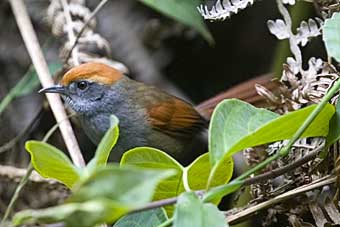 One of the attractions of Boa Nova is the variety of habitats. Today we will visit the humid forest in the morning, the dry forest in the afternoon and return to the "lajeiro" at dusk.
One of the attractions of Boa Nova is the variety of habitats. Today we will visit the humid forest in the morning, the dry forest in the afternoon and return to the "lajeiro" at dusk.
Unfortunately my flash gun began to give problems. After about 10 years of bashing it about in the field I have managed to loosen the base and the contacts are not secure but I manage to make a temporary repair. We see a variety of excellent birds in the humid forest including Black-throated Trogon, Tufted and Variable Antshrike, Spot-breasted Antvireo, Plain-winged and Lesser Woodcreeper, Black-billed Scythebill, Bahia Spinetail, Striated Softtail, Fork-tailed Tody-tyrant, White-throated Spadebill and Pin-tailed Manakin. We also had a Mantled Hawk briefly flying over us at the height of the canopy.
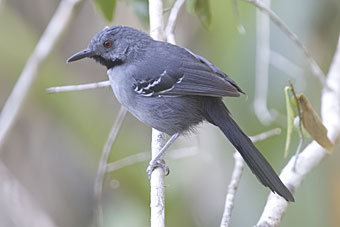 After lunch and a very welcome siesta we set off for the dry forest where we had excellent views of the rare and Endangered Slender Antbird, the male and female Narrow-billed Antwren which is classified as Near Threatened and the common but still-to-be-photographed-by-me Hangnest Tody-tyrant. The habitat is known locally as "mata de cipó" and is a bit like caatinga but with less thorns and with these curious ground bromeliads known as "gravata" which gives the Slender Antbird the local name of "gravatazeiro".
After lunch and a very welcome siesta we set off for the dry forest where we had excellent views of the rare and Endangered Slender Antbird, the male and female Narrow-billed Antwren which is classified as Near Threatened and the common but still-to-be-photographed-by-me Hangnest Tody-tyrant. The habitat is known locally as "mata de cipó" and is a bit like caatinga but with less thorns and with these curious ground bromeliads known as "gravata" which gives the Slender Antbird the local name of "gravatazeiro".
On our way back to the hotel we paid another visit to the lajeiro but the hummingbird activity was a bit less than yesterday. We were told that over a dozen different species of hummingbird have been seen at this site.
Wednesday, 29th October: Boa Nova to Macarani
Although this was programmed to be a day of mainly travel we set off early back to the humid forest looking principally for the local Tapaculo and the Rio de Janeiro Antbird, a bird we had missed yesterday. The forest was generally a lot quieter and we saw neither of these birds. I did manage to photgraph Cinnamon-vented Piha, Flame-crested, Gilt-edged and Buff-breasted Tanagers and Green-winged Saltator and we saw some other fairly common birds.
We arrived at Macarani at about 3:00 p.m. and eventaully managed to wake the hotel owner who told us that he had no rooms vacant but there would be some free if we returned at 5:00 p.m. Very curious but I think nothing more serious than a bout of laziness. We took the opportunity of going on a "scout" to the Mata de Balbina where we were hoping to see Streseman's Bristlefront the next day. The drive was over an hour and a quarter along a pretty bumpy dirt road but I'm glad we did it because it gave us the measure of the task ahead. We could get the car so far and no further and it looked like a long, hard climb to the forest. We headed back along the dirt road, which locals told us was impassable in the rainy season, checked into our hotel without any problems and headed for the supermarket to lay in stores for the next day's adventure.
Thursday, 30th October: Mata de Balbina
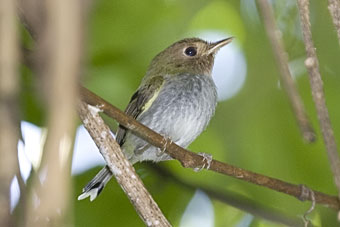 What a day. We were up at 2:45 a.m. and on the road by 3:00. We parked the car at about 4:15 and started hiking up the hill. I found it very tough going partly because I am a bit overweight and partly because I was carrying all my kit plus lots of water plus my share of the lunch supplies.
What a day. We were up at 2:45 a.m. and on the road by 3:00. We parked the car at about 4:15 and started hiking up the hill. I found it very tough going partly because I am a bit overweight and partly because I was carrying all my kit plus lots of water plus my share of the lunch supplies.
We arrived at the forest at about 6:00 a.m. and immediately saw what looked like a White-barred Piculet but not exactly like the ones I know. Maybe another hybrid? Along the trail a bit and Ciro played the Bristlefront tape. There was an immediate reply much to everyone's joy and relief. We bushwhacked downhill towards the call but, after an hour had had no sight of the bird. Back on the trail again we saw a variety of birds many of which were new to me or I hadn't photographed before such as White-wedged Piculet, Streak-capped Antwren, Black-headed Berryeater and Yellow-green Grosbeak.
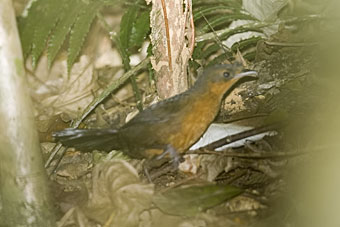 But we heard no further sound from the Stresemann's
Bristlefront so we headed back to the original spot, had our lunch and a short
siesta as well as getting some excellent photos of Fork-tailed Tody-tyrant
which seems to be fairly common here. We headed back down the hill where the
tape produced a distant response. We moved carefully towards it and came
across an overgrown, dry gully which seemed to me to be very similar to Slaty
Bristlefront habitat. We settled down, waited for about 10 minutes then
played the tape which produced an instant and very close response. After a
while Ciro and I saw the bird, a female, skulking around the base of a fallen
tree but Moira and Graeme were blocked from view. Carefully they got into
position and saw the bird so Ciro and I then tried to get a photograph. This
is in very low light with lots of vegetation so flash and manual focussing are
called for. Eventually we both got some photos much to our great delight
because there are very few photos of this bird. Indeed very few people have
even seen this Critically Endangered species known only from two specimens
dated 1830 and 1945 until it was re-discovered at Una in 1995 never to be see
there again. In 2004 Romulo Robin discovered a few birds in this small forest
remnant.
But we heard no further sound from the Stresemann's
Bristlefront so we headed back to the original spot, had our lunch and a short
siesta as well as getting some excellent photos of Fork-tailed Tody-tyrant
which seems to be fairly common here. We headed back down the hill where the
tape produced a distant response. We moved carefully towards it and came
across an overgrown, dry gully which seemed to me to be very similar to Slaty
Bristlefront habitat. We settled down, waited for about 10 minutes then
played the tape which produced an instant and very close response. After a
while Ciro and I saw the bird, a female, skulking around the base of a fallen
tree but Moira and Graeme were blocked from view. Carefully they got into
position and saw the bird so Ciro and I then tried to get a photograph. This
is in very low light with lots of vegetation so flash and manual focussing are
called for. Eventually we both got some photos much to our great delight
because there are very few photos of this bird. Indeed very few people have
even seen this Critically Endangered species known only from two specimens
dated 1830 and 1945 until it was re-discovered at Una in 1995 never to be see
there again. In 2004 Romulo Robin discovered a few birds in this small forest
remnant.
Elated but exhausted we then headed back down the hill. Just at the forest edge there was a small antswarm accompanied by a Rio de Janeiro Antbird which showed very well. What a bonus. But I was just too tired to get out my camera and take its photo.
Friday, 31st October: Macarani to Porto Seguro
We woke up to more heavy rain. No birding this morning
so we had a long lie and off to the padaria for breakfast at 7:00 a.m. since
breakfast was one of the many things that the hotel did not offer. The drive
to Porto Seguro was relatively short and we 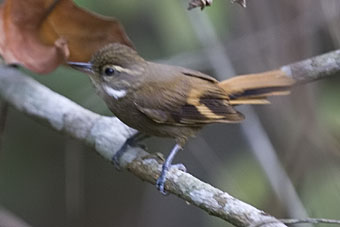 arrived at the Pousada das Araras in Porto Seguro at about 11:30 then off to the Restaurant Portinho for an excellent x kilo lunch.
arrived at the Pousada das Araras in Porto Seguro at about 11:30 then off to the Restaurant Portinho for an excellent x kilo lunch.
After a siesta we headed for the nearby Veracel reserve which is a very nice piece of lowland Atlantic Forest preserved by the Veracel paper company. The afternoon was relatively quiet but I got some excellent photos of Buff-throated Woodcreeper, White-crowned Manakin, Red-legged Honeycreeper, Golden-spangled Piculet, Moustached Wren and a very obliging Plain Xenops that I reckon must have been nesting. It perched horizontally at first which is most unusual then moved to a more normal vertical stance but performed a display with its wings opening and closing rapidly.
Saturday, 1st November: Porto Seguro
After an excellent early breakfast at 4:30 a.m. we set
off for the Veracel Reserve. It was fairly quiet, possibly because the rains
have not yet arrived this year but I did get some good photos of Sooretama
Slaty-Antshrike, White-bellied Tanager, Crested Becard, Red-stained
Woodpecker, Red-rumped Cacique performing a display at the nest,
Chestnut-backed Antshrike and distant pictures of Blue-throated  Parakeet. We then came across some lovely flowering bushes that were covered in hummingbirds mainly Swallow-tailed Hummingbird and, a new one for me, Rufous-throated Sapphire.
Parakeet. We then came across some lovely flowering bushes that were covered in hummingbirds mainly Swallow-tailed Hummingbird and, a new one for me, Rufous-throated Sapphire.
After another excellent lunch and a siesta we went back to the reserve with our eyes mainly on the canopy as we were searching for cotingas both the Banded Cotinga which we didn't see and the White-winged Cotinga which we did see. We also heard but did not see Bare-throated Bellbird. I managed to get photos of the local race of Swallow-wing, the Vulnerable Band-tailed Antwren and the Endangered Red-browed Amazon as well as the difficult-to-see Thrush-like Schiffornis. All in all not bad for a slowish day in the Atlantic Forest.
Sunday, 2nd November: Porto Seguro to Camacã
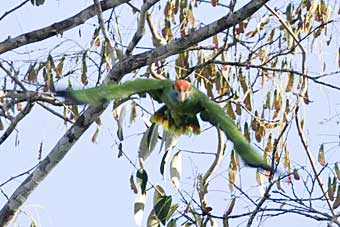 Up and out at 4:30 and off to the Vearcel reserve again. Again we were scanning mainly for cotingas but with limited success apart from some more White-winged Cotinga. There was nothing new compared to yesterday but I did manage to get better photos of Band-tailed Antwren and Red-browed Parrot.
Up and out at 4:30 and off to the Vearcel reserve again. Again we were scanning mainly for cotingas but with limited success apart from some more White-winged Cotinga. There was nothing new compared to yesterday but I did manage to get better photos of Band-tailed Antwren and Red-browed Parrot.
After breakfast back at the hotel we set off for
Camacã where we arrived at about 2:00 p.m. to be met at the bottom of the hill
by the owner, Victor Becker. He assured us that our car would get up the hill
which it did eventually but not after some difficulty. It is much better to
leave your vehicle in town and get Victor to take you up in his 4WD. I had
visited the Serra Bonita Reserve before when Victor was in the process of
building his road and lodge so it was interesting to see it completed. It is
very impressive with a research block in which he houses his collection of
over 250,000 specimens of Neotropical moths and a very well designed lodge
which has all the comforts that Victor didn't find during his 40 years in the
field collecting his moths (which we reckoned he must have done at a rate of
about 20 specimens collected and prepared every single day.) Features of the
lodge include a balcony over the forest, a magnificent plate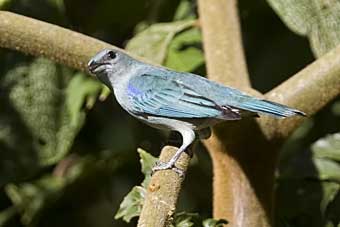 glass window onto the balcony, a great shower and a very nice, well-lit desk at which one can write up one's notes. He is also installing broadband in each of the rooms. Their website is http://www.uiracu.org.br/en/index.html
glass window onto the balcony, a great shower and a very nice, well-lit desk at which one can write up one's notes. He is also installing broadband in each of the rooms. Their website is http://www.uiracu.org.br/en/index.html
We photographed several species around the lodge including Azure-shouldered Tanager, Yellow-legged Thrush, Crescent-chested Puffbird and White-wedged Piculet before heading towards the research centre where Victor has set up some hummingbird feeders. There we saw Black-throated Mango, Scale-throated Hermit, Swallow-tailed Hummingbird, Sombre Hummingbird, Black Jacobin, Violet-capped Woodnymph and Brazilian Ruby as well as Green-headed Tanager, Green Honeyeater and Cliff Flycatcher. Victor also has a Tayra that follows him around the place.
Monday, 3rd November: Camacã - Serra Bonita Reserve
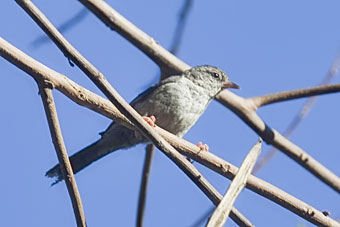 I was up at 4:30 to watch the sunrise through the trees
from my balcony. Then we were off along the road which is excellent for
birding and nowhere is it too steep. We saw a variety of great birds including
White-eyed Foliage-gleaner, Lesser Woodcreeper, Rufous-breasted and
Scale-throated Hermits, Pallid Spinetail and Lemon-chested Greenlet. The star
of the morning though was the Pink-legged Graveteiro. This is another recently
discovered species having been described as recently as 1996. It is restricted
to the "cabruca" canopy of the lowland forest that shades the cocoa
plantations in the south-east of Bahia. Since the virtual demise of the cocoa
trade in this part of the world the habitat is under threat and the Serra
Bonita
I was up at 4:30 to watch the sunrise through the trees
from my balcony. Then we were off along the road which is excellent for
birding and nowhere is it too steep. We saw a variety of great birds including
White-eyed Foliage-gleaner, Lesser Woodcreeper, Rufous-breasted and
Scale-throated Hermits, Pallid Spinetail and Lemon-chested Greenlet. The star
of the morning though was the Pink-legged Graveteiro. This is another recently
discovered species having been described as recently as 1996. It is restricted
to the "cabruca" canopy of the lowland forest that shades the cocoa
plantations in the south-east of Bahia. Since the virtual demise of the cocoa
trade in this part of the world the habitat is under threat and the Serra
Bonita 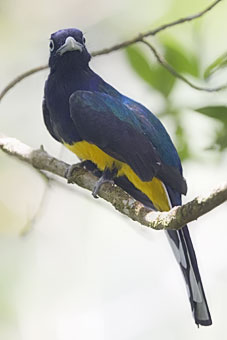 Reserve is one of the better places to see this species. It is an ovenbird that nests high up in the canopy and while we had magnificent views of the bird it proved quite difficult to get a good photo.
Reserve is one of the better places to see this species. It is an ovenbird that nests high up in the canopy and while we had magnificent views of the bird it proved quite difficult to get a good photo.
We were enjoying this place so much that we asked Ciro and Victor if we could stay a second night. Fortunately this was possible though Ciro had to unscramble the arrangements for Una which we were going to have to sacrifice. I managed to get some great photos around the lodge either side of lunch and from my balcony managed to photograph Drab-breasted Bamboo-tyrant, Spot-breasted Antvireo, White-wedged Piculet and a male White-tailed Trogon that was perched only a few metres away. I had to walk backwards to get the bird at my minimum focus distance. There was also a small family group of Weid's black-tufted-ear Marmoset for a bit of mammalian interest.
In the afternoon, Victor took us to the top of the hill in his jeep and we walked back down a lovely trail towards the lodge. It was relatively quiet but we did get great views of a Such's Antthrush as well as a very interesting ovenbird which Ciro believes to be a new species currently being described.
Tuesday, 4th November: Camacã to Ituberá
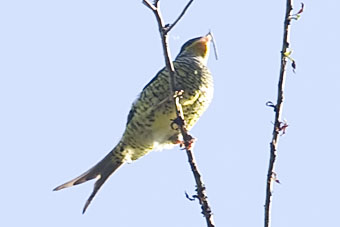 Up again at 4:30 to watch the dawn from the balcony then off down the road again where we saw several good birds including Spot-backed Antshrike, Grey-hooded Atilla, Pink-legged Graveteiro, Pale-browed Treehunter, a very relaxed White-eyed Foliage-gleaner, Ferruginous Pygmy-owl, Streaked Xenops, Long-tailed Tyrant, Three-striped Flycatcher and a pair of Chestnut-crowned Becard building a nest. Well she was building it while he watched. Star of the morning though was a pair of Swallow-tailed Cotinga preening and carrying nesting material. This bird is rarely recorded in the state of Bahia.
Up again at 4:30 to watch the dawn from the balcony then off down the road again where we saw several good birds including Spot-backed Antshrike, Grey-hooded Atilla, Pink-legged Graveteiro, Pale-browed Treehunter, a very relaxed White-eyed Foliage-gleaner, Ferruginous Pygmy-owl, Streaked Xenops, Long-tailed Tyrant, Three-striped Flycatcher and a pair of Chestnut-crowned Becard building a nest. Well she was building it while he watched. Star of the morning though was a pair of Swallow-tailed Cotinga preening and carrying nesting material. This bird is rarely recorded in the state of Bahia.
After breakfast we bid fond farewells to Victor and
his charming wife and set off on the road 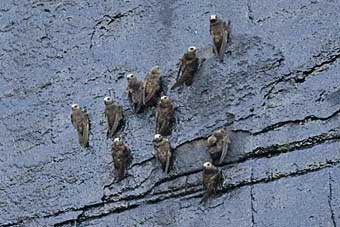 north. We arrived at the Fazenda Michelin near Ituberá in the early afternoon and the first thing we noticed was the smell of rubber - not the most pleasant. Michelin have extensive rubber plantations here but they also have a very nice reserve of lowland Atlantic Rain Forest.
north. We arrived at the Fazenda Michelin near Ituberá in the early afternoon and the first thing we noticed was the smell of rubber - not the most pleasant. Michelin have extensive rubber plantations here but they also have a very nice reserve of lowland Atlantic Rain Forest.
Wednesday, 5th November: Ituberá to Arambepe
Up at 5:00 a.m. for a welcome cup of coffee and then
off to the forest with the resident biologist, Zedomar. There was lots of
activity but our time was taken up with two great birds. The bird we were here
to see was the Bahia Tapaculo. It was extremely shy and it took us a
considerable amount of time before we tracked one down. Eventually we had
pretty good views of it and noticed its distinctive unbarred flanks.
Unfortunately I only got a few poor photos before Zedomar, quite rightly, led
us away so as not to disturb this Critically Endangered species too much. 
The other great bird was Pheasant Cuckoo. This bird is normally extremely difficult to see but we first heard it calling then it came into playback and showed extremely well. I had it clear in my viewfinder in a classic pose for the photo of a lifetime but unfortunately it moved. On our return from the Tapaculo site it was still flying around, in fact there were two of them, and I managed to get a consolation photo of the bird singing from a horizontal perch.
This proved to be the spectacular finale to the Wallace's trip as they were off back to Scotland the next morning. We planned to stay at Arambepe for the night, partly because it was convenient for Salvador Airport and partly because it would be a good base for my last few days with Ciro.
Our journey included a crossing on the ferry to Salvador and a drive through Salvador to the beaches on the north. I had been on a holiday with my family and with Jeremy Minns and his family way back in 1976 when we had visited a sleepy little fishing village called Arambepe so it was interesting to go back again after all these years. It is much changed but still very pleasant.
Thursday, 6th November: Camaçari
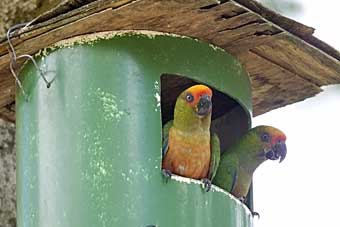 A long lie this morning followed by breakfast at 7:00 since we had to take Moira and Graeme to the airport. After saying our fond farewells, Ciro and I headed to Cetrel, a company that treats industrial effluent and which owns a large area of cerrado. We were there by courtesy of Pedro Lima who works for Cetrel.
A long lie this morning followed by breakfast at 7:00 since we had to take Moira and Graeme to the airport. After saying our fond farewells, Ciro and I headed to Cetrel, a company that treats industrial effluent and which owns a large area of cerrado. We were there by courtesy of Pedro Lima who works for Cetrel.
One of the first things that strikes you at Cetrel is
the number of artificial nest boxes that are around. Pedro Lima has erected
these, made out of large guage piping largely to help the population of
Golden-capped Parakeet. He started with 5 pairs of this Vulnerable parrot and
now has over 300 birds in the area. The artificial nests are used by other
birds as well including Ferruginous Pygmy-owl, Tropical Screech-owl and
American Kestrel.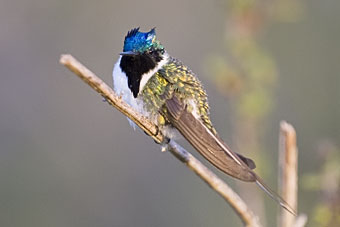
We had lunch back at Arambepe where there was a pair
of Semipalmated Plover and some Turnstone on the shore before heading back to
the cerrado at Cetrel. There we saw several cerrado specialists including
Yellow-billed Blue Finch and Horned Sungem. It was quite strange seeing a
Horned Sungem within about 10 kilometres of the coast but the habitat is
exactly right so why not. This male was moving around its territory and would
perch for about 50 seconds before twitching its tail and zooming off to
another perch. We watched and photographed it for about 20 minutes before the
light became too poor for photography.
Friday, 7th November: Camaçari to São Francisco de Paraguaçu
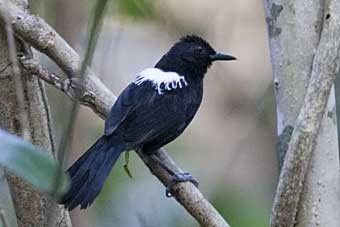 At Pedro Lima's invitation we headed off to São Francisco de Paraguaçu. I was told that this was the type locality of Fringe-backed Fire-eye and, after climbing through a few barbed wire fences and playing the tape, a pair duly arrived. Mind you it was about the only bird we saw all day as the forest is very disturbed and seems to be disappearing fast. We then headed to the village of Santiago de Iguape to look for the fisherman who had discovered a roost of Scarlet Ibis in the nearby mangroves. He was not to be found and another fisherman told us that the roost had recently moved.
At Pedro Lima's invitation we headed off to São Francisco de Paraguaçu. I was told that this was the type locality of Fringe-backed Fire-eye and, after climbing through a few barbed wire fences and playing the tape, a pair duly arrived. Mind you it was about the only bird we saw all day as the forest is very disturbed and seems to be disappearing fast. We then headed to the village of Santiago de Iguape to look for the fisherman who had discovered a roost of Scarlet Ibis in the nearby mangroves. He was not to be found and another fisherman told us that the roost had recently moved.
At the enormous old colonial church at Santiago de Iguape I managed to get some good flight shots of Sick's Swift and, in the evening, I was photographing the same species at their night-time roost which happened to be in a well in the garden next to Pedro Lima's house. I had to stand on the rim of the well to get a decent photograph and suddenly lost my balance. Having broken bones on a couple of recent trips I had the presence of mind to fall backwards into a bush with my arms in front of me. Much to my relief no bones were broken but, as I was dusting myself off, I noticed that my flash-gun had been ripped from my camera. So no more flash for my trip down south!
Saturday, 8th November: São Francisco de Paraguaçu to Arambepe
A disappointing last morning as the forest here really has been pretty badly destroyed but it was worth the trip if only to see a rarely visited forest remnant. We saw a pair of Chestnut-bellied Seed-Finch, a bird that has virtually disappeared from the wild in these parts due to trapping for the caged bird trade. And at least we ended with a nice mystery bird when we went to look at the old colonial convent at São Francisco de Paraguaçu. This is an amazing and enormous building which, I am told, is being restored on the inside. Outside we saw a group of piculets. I am getting increasingly confused with piculets and I hope that someone is studying them. These looked mostly like Spotted Piculet but had barring in the lower belly and flanks looking a bit like Golden-spangled.
We headed back for a last night at Arambepe. I spent the afternoon getting packed up then Ciro and I had a superb evening meal, a caiparinha or two and a few beers to celebrate what had been a magnificent and memorable trip. I am truly amazed at the number of rare and difficult birds that we have seen over the past few weeks and I have to thank Ciro for his skill in finding these birds.
Tomorrow I fly to São Paulo to spend a few days with Jeremy Minns and Ricardo Parrini in Teresópolis then a few more days with Jeremy at Itatiaia.